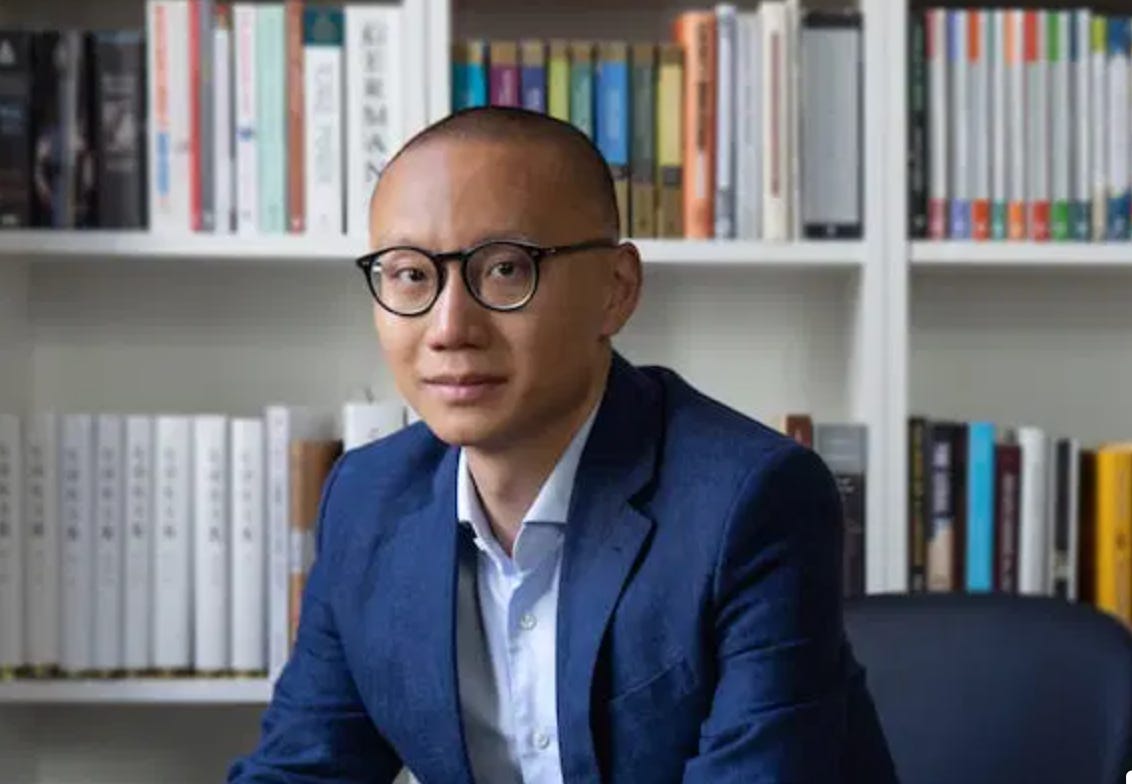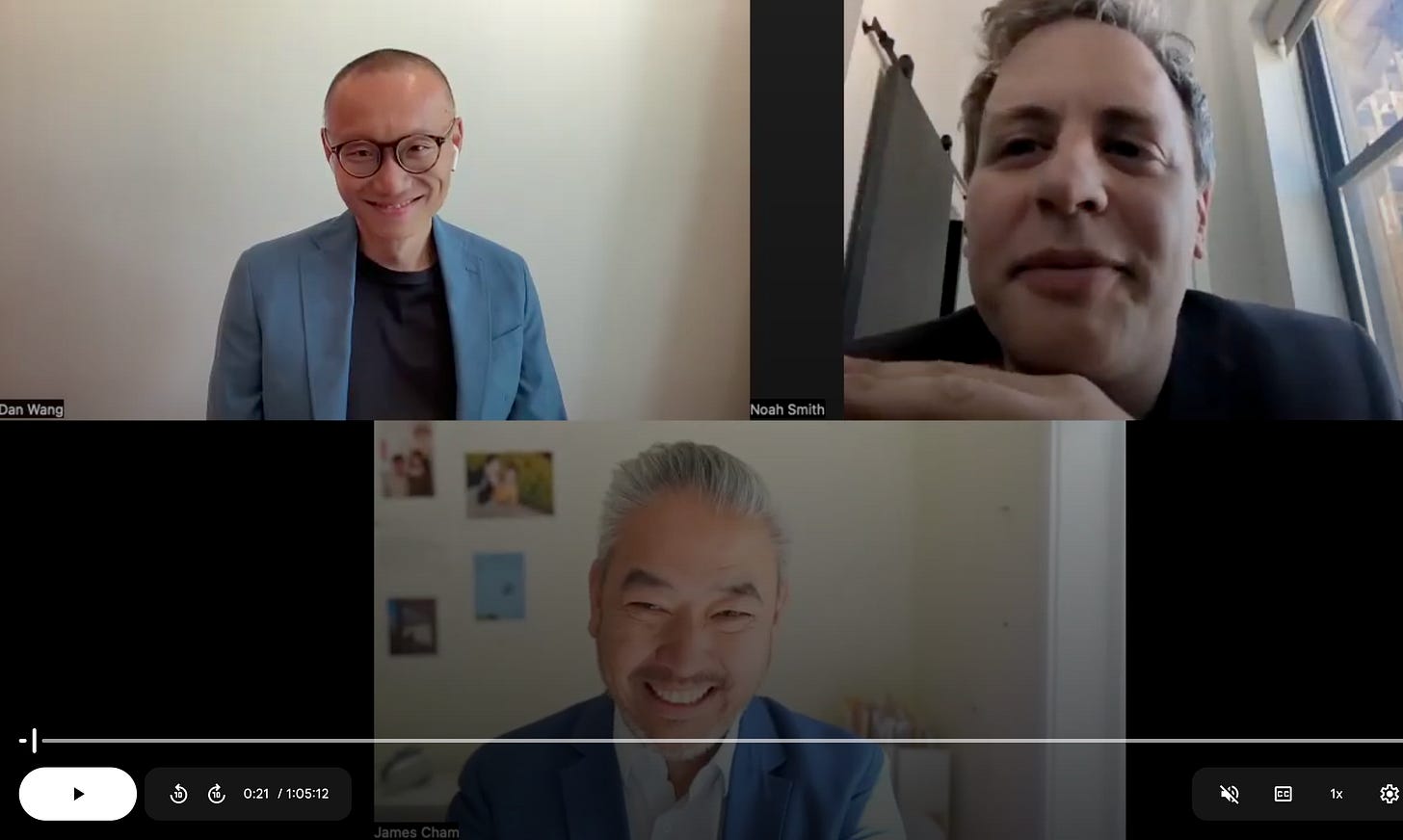On Dan Wang’s Brand-New "Breakneck": The World's Dynamos China & America, & Building Our Common Global Future Home
The Sledgehammer & the Gavel at Dawn & Dusk: Synthesis, strife, and the race to shape the twenty-first century; how China & America build—and block—their common future. Dan Wang’s brand-new Breakneck offers a sharp, firsthand account of the rivalry between China’s engineering state & America’s lawyerly society. Through vivid reporting and incisive analysis, Wang exposes how these two restless giants drive global change—at breakneck speed & at neck-breaking cost. The book rejects easy labels and caricatures, arguing that true progress demands a synthesis of ambition and restraint, building and blocking. Wang’s lived experience across continents provides a blueprint for understanding the trade-offs that will shape the twenty-first century, urging readers to break free of clichés and confront the complexities of our global future…
My friend Dan Wang's Breakneck: China's Quest to Engineer the Future is out this week. It launches Tuesday, August 26: <https://www.amazon.com/dp/1324106034/> <https://danwang.co/breakneck/>.
Wang, Dan. 2024. Breakneck: China's Quest to Engineer the Future. New York: Farrar, Straus and Giroux. <https://danwang.co/breakneck/>.
I am biased, because he is my friend. However, you need to read it. I would say the same thing if I did not know him from Adam. And I am not alone: Tyler Cowen calls it "arguably the best book of the year". John Thornhill calls it "compelling, provocative and highly personal". Patrick Collison claims that it "illuminates China like no one else". Tracy Alloway calls him "one of the best China writers out there".
Breakneck is Dan Wang’s sharp, lived account of a world with two dynamos: the “thrilling, maddening, and bizarre” engines of change that are China and the United States.
James Cham and Noah Smith interviewed Dan about the book on a Bloomberg zoom last Friday. Below are my Chatham House-style notes on the conversation. But, first, let me transcribe the opening:
Dan Wang: Noah, want to tell us a good joke?
Noah Smith: Me? Yes! What do you call a pig with three eyes?
Dan Wang: What’s that, Noah?
Noah Smith: Pi-i-i-g!
James Cham (loses it): That’s terrible!
Noah Smith: I got another one!
James Cham: OK!
Noah Smith: What do you call an elephant crossed with a rhino?
Dan Wang: What’s that?
Noah Smith: Hell if I know!
James Cham: OK. That’s painful.
Dan Wang: That’s not as good as the pig…
My Chatham-Style Notes:
China and America as “Dynamos” of Global Change: Breakneck is Dan Wang’s sharp, lived account of a world with two dynamos: the “thrilling, maddening, and bizarre” engines of change that are China and the United States. China solves problems with concrete, steel, and scale and then extends that mindset into counterproductive social engineering. America solves problems with rights, litigation, and vetoes—protecting freedoms while sacrificing speed and ambition…
The Sledgehammer vs. the Gavel: Engineering State vs. Lawyerly Society: Breakneck sees China as the country of the sledgehammer. Breakneck sees America as the country of the gavel. China’s technocratic engineering élite solves problems with concrete, steel, and scale—roads, bridges, power plants, hyperscale projects. The impulse extends to society: the one‑child policy and repression in Tibet and Xinjiang. This technocracy prizes order, control, and visible achievement. America’s lawyer élite solves problems by assigning and vindicating rights to property and security. Enterprise and innovation follow as people live as they wish…
The Need for Synthesis, Not Choosing Sides: The big payoff isn’t choosing sides but synthesizing strengths: engineering drive with rights and due process. If either Silicon Valley or the Pearl River Delta could balance engineering scale and ambition with strong legal rights and safeguards, it would be unstoppable. About 20% more building-engineering in America, about 40% more respect for rights-process in China, and each would truly attain the utopian hopes and dreams of a John Winthrop or of a Chéng Wáng (成王)...
Lived Experience as the Foundation for Analysis: Read it for the reporting as much as the argument. It is a field guide to the trade‑offs that will determine the twenty‑first century, for Dan Wang lives his China story—streets, factories, lockdowns—and writes with the analyst’s clarity, the reporter’s eye, the insider’s local knowledge, and the outsider’s perspective. Breakneck is a corrective to clichés and a blueprint for balancing ambition with restraint…
Restless Transformation as a Shared Trait: At bottom, Americans and Chinese are alike. The likeness stands out when you compare Chinese to Japanese or Koreans, and Americans to Canadians or Europeans. Both peoples are restless, eager for shortcuts, and drive much of the world’s change. Both mix crass materialism with admiration for entrepreneurs. Both tolerate tastelessness. Both love competition. Both are pragmatic—“get it done”—and often rush work…
Old Labels Don’t Fit: Beyond “Socialist,” “Democratic,” or “Neoliberal”: Both countries are tangles of imperfection, often their own worst enemies. Old labels—“socialist,” “democratic,” “neoliberal”—do not fit. China delivers rapid, visible progress, but at a cost to rights and with risks of overreach. It goes off track with social engineering, becoming a Leninist technocracy with grand‑opera traits—practical until it turns preposterous. America goes off track by spending too much time specifying and vindicating rights, becoming a super‑litigious veto‑ocracy…
China’s Technocratic Elite & the Bias for Building: China’s technocratic engineering élite solves problems with concrete, steel, and scale—roads, bridges, power plants, hyperscale projects. The impulse extends to society: the one‑child policy and repression in Tibet and Xinjiang. This technocracy prizes order, control, and visible achievement…
The Chinese View: China would benefit from about 40% more legal respect for rights and process. Yet China’s élite sees less than zero appeal in any system that can elevate a Donald Trump instead of a Xi Jinping…
America’s Lawyerly Elite and the Reflex to Create Rights: America’s lawyer élite solves problems by assigning and vindicating rights to property and security. Enterprise and innovation follow as people live as they wish. The reflex response to any problem is to create another entitlement or right, pulling more people into the set required for agreement and approval…
U.S. Sclerosis: The U.S. once built ambitiously—the late 19th century and the post‑WWII decades. It should reclaim roughly 20% more building and engineering spirit. American failure shows even at the frontier of the global economy. Silicon Valley prizes invention, then builds oligopoly moats from network effects and legal maneuvering. China, by contrast, prizes scale and production, embracing the Andy Grove ethic…
The Path-Dependence of Development & Political Economy: Development theory says early stages prioritize building; later stages prioritize allocation. As marginal utility of capital falls, rule‑crafting and market design matter more; lawyers, regulators, and policy architects rise. But transitions are path‑dependent. China still builds beyond Western expectations due to political economy: entrenched interests, Party structure, and a state‑citizen contract keep bulldozers running…
China’s “Involution” & Overcapacity as Both Weakness & Strength: “Industrial policy”’s costs are real. Subsidies, cheap loans, and local protectionism create overcapacity. Every province backs an EV maker; profits go to zero; firms steal tech; BYD faces near‑clones. China calls this “involution”; Japan called it “overcompetition.” It is larger‑scale now. Still, do not mistake dysfunction for weakness. Despite weak consumption, property woes, demographics, and political risk, China remains a technological peer…
The Role of Institutional Memory & Process Knowledge: U.S. tech should learn China’s process‑knowledge playbook: how firms transfer and scale operational expertise. JVs are not the main channel; informal networks matter more. The path to better policy starts with humility, curiosity, and hard work. End lazy thinking. Our ability to navigate a world shaped by others’ dynamism depends on it…
Epistemic Humility & the Limits of Outsider Understanding: It is tempting to attribute such differences to deep-seated cultural traits, but that would be a mistake. The reality is more prosaic: cognitive endurance—what one might call “institutional memory”—is shaped as much by habits (perhaps even by the absence of alcohol, as Wang jokes) as by any “Asian” characteristic. The crucial point is epistemic humility. Both China and the United States are, in their own ways, bizarre and opaque to outsiders and even to their own citizens. The only defensible stance is curiosity, not certainty…
The Persistent Power of the State in China: Most striking is the state’s power over entrepreneurship. The story of China’s EdTech crackdown is illustrative. In late 2020, flush with confidence after its successful pandemic response (especially in contrast to the chaos in the United States), the Communist Party embarked on a campaign of “major structural reform.” The government moved swiftly to rein in tech giants, motivated by concerns that private platforms had gained too much influence over what people see, think, and buy—a concern shared, in different forms, by policymakers in the U.S. and Europe. Yet the Chinese approach was far more direct and draconian.”..
America’s Shift from Creative Dealmakers to Litigious Regulators: Through the nineteenth and into the early twentieth century, the country’s lawyers were, above all, creative dealmakers. They raised capital for railroads, navigated the complexities of eminent domain, and facilitated the construction of the infrastructure that made the United States an economic powerhouse. The lawyerly society, in this era, was one of action—enabling, not obstructing, economic growth. The postwar period, however, marked a significant shift. Even as late as Franklin D. Roosevelt’s New Deal, lawyers in government were focused on pragmatic problem-solving. But by the 1950s, the American engineering state had run amok: highways slashed through cities, DDT and other pesticides were sprayed with abandon, and the nation embarked on disastrous military adventures in Asia…
The 21st-Century Task: Synthesize the Best, Avoid the Worst: Breakneck is a meditation on trade‑offs—ambition vs. restraint, building vs. blocking, sledgehammer vs. gavel. The 21st‑century task is to synthesize the best of both while avoiding the worst of each. The true City on a Hill, the true Central Country, will be the one that best accomplishes that task. And might turn out, come 2100, to be the same trans-Pacific civilization…
What Makes Breakneck Extra Special: How it blends theory, economic data, sociology, and personal observation. Too much China talk is distant and derivative—third‑hand reporting and think‑tank abstraction. Wang lives it: food, streets, cities, politics, in China, America, and Canada, able to see each one both as a native insider and as a visiting outsider. Thus if you want to know what is happening and what it feels like, read the entire book. He lets readers see, feel, and taste these movers and shakers in the contemporary world. Details that seem like color become the substance of understanding. Read it for the reporting as much as the argument. Break free of clichés and caricatures.


